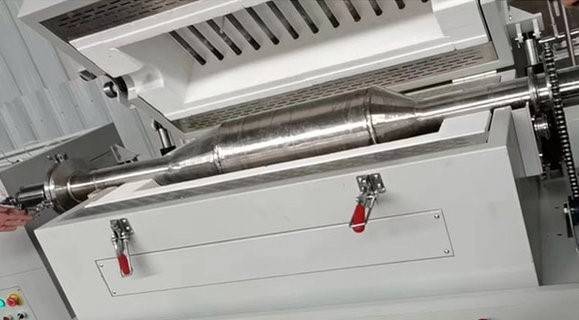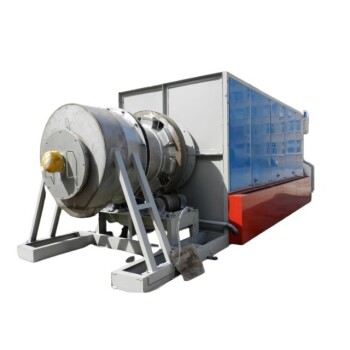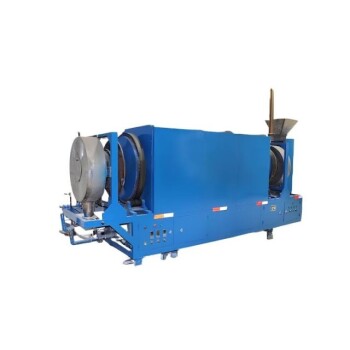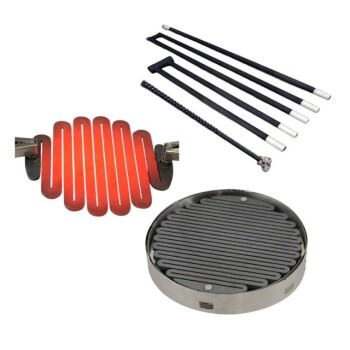
Rotary Furnace
Split Multi Heating Zone Rotary Tube Furnace Rotating Tube Furnace
Item Number : KT-MRTF
Price varies based on specs and customizations
- Max. temperature
- 1200~1600℃
- Heating zones quantity
- 2-8 zones
- Furnace tube diameter
- 30~280 mm
Shipping:
Contact us to get shipping details Enjoy On-time Dispatch Guarantee.
Why Choose Us
Reliable PartnerEasy ordering process, quality products, and dedicated support for your business success.
Explore the Split Multi Heating Zone Rotary Tube Furnace
This advanced furnace is engineered for precision and versatility in high-temperature material processing. Below are some key visual details and features:


Key operational features include:
- Intelligent 50-segment programmable automatic temperature control.
- Heating rate of 0~20°C/min, with temperature control accuracy of ±1℃.
- A top-opening furnace cover design allows for real-time observation of heating materials.
- The furnace body offers an adjustable tilt angle from 0 to 30 degrees for convenient loading and unloading.
- Furnace tube speed is adjustable (e.g., 3~7 rpm, reversible), ensuring materials are fully turned and heated evenly.
- Incorporates safety functions such as door-open power-off, over-temperature alarm, and leakage protection.

Product Overview & Capabilities
The Split Multi Heating Zone Rotary Tube Furnace is an advanced system meticulously designed for precise high-temperature processing. It boasts 2-8 independently controlled heating zones, each equipped with its own thermal controller. This configuration ensures superior temperature management, enabling the creation of both uniform thermal fields and specific, large temperature gradients as required by your experiments.
Key functionalities include continuous furnace tube rotation with stepless speed regulation and an adjustable tilting mechanism (0-30 degrees). These features facilitate optimal material handling, ensure even heat exposure, and improve process efficiency. Engineered for versatility, this furnace operates effectively under both vacuum and controlled atmosphere environments. This makes it exceptionally well-suited for a diverse range of applications, including calcination, drying, high-temperature reactions, heat treatment, carbonization, sintering, and pyrolysis of various materials. To further enhance performance, design options such as internal lifting plates (to prevent material hardening and ensure uniform heating) or a middle "big belly" type furnace tube (for improved heating results) can be incorporated.
Key Advantages for Your Laboratory
- Multi-Independent Heating Zones for Ultimate Precision: Achieve superior and flexible temperature control with 2-8 independent zones, perfect for establishing uniform thermal fields or significant, controlled temperature gradients across the material.
- Superior Heating & Insulation for Durability and Efficiency: High-quality resistance wire heating elements combined with excellent thermal insulation ensure a long service life, promote energy efficiency, and deliver stable, reliable high-temperature performance.
- PID Intelligent Thermal Control for Accuracy: Experience precise heating and outstanding thermal uniformity thanks to our PID intelligent thermal control system, which minimizes temperature fluctuations and maintains tight control.
- User-Friendly 7-inch TFT Touch Screen Interface: Easily program complex heating schedules, set operational parameters, and review historical temperature data through the intuitive 7-inch true color touch screen, simplifying operation and data analysis.
- Stable & Widely Adjustable Rotating System: The robust rotating system, driven by a frequency conversion motor, offers stepless speed regulation for smooth, stable, and low-noise operation, adaptable to diverse experimental requirements.
- Flexible Electric Drive Tilting for Process Control: The electrically driven tilting mechanism allows for precise adjustment of the furnace inclination angle, offering flexible control over material movement and simplifying loading and unloading procedures.
- Advanced Vacuum & Controlled Atmosphere Operation: Our unique stable and dynamic vacuum sealing technology enables operations in both high vacuum and various controlled atmospheres, meeting a wide spectrum of research and processing needs.
Versatile Applications
Multi-zone rotary tube furnaces are widely utilized across various industries and research fields due to their adaptability and precision:
- Material Processing: Ideal for calcination, drying, heat treatment, carbonization, sintering, and high-temperature pyrolysis of diverse materials. This includes positive and negative electrode materials for lithium-ion batteries, rare earth materials, chemical catalytic materials, magnetic materials, powder metallurgy materials, nonferrous metal materials, and powder or granular forms of kaolin and other non-metallic mineral materials.
- Chemical Reactions: Excellently suited for high-temperature reactions involving gases, liquids, or solids, such as Chemical Vapor Deposition (CVD), Physical Vapor Deposition (PVD), and thermal decomposition processes.
- Materials Characterization: Facilitates thermal analysis techniques, including Thermogravimetric Analysis (TGA) and Differential Thermal Analysis (DTA), to investigate the thermal behavior and properties of materials.
- Quality Control: Essential for the testing and evaluation of materials, assessing their thermal stability, reactivity, and other critical performance characteristics.
- Research and Development: Empowers scientists and engineers in the investigation of new materials, novel processes, and emerging technologies across fields like materials science, chemistry, and engineering.
Technical Specifications
| Furnace model | KT-MRTF12 | KT-MRTF14 | KT-MRTF16 |
|---|---|---|---|
| Max. temperature | 1200℃ | 1400℃ | 1600℃ |
| Constant work temperature | 1100℃ | 1300℃ | 1500℃ |
| Heating rate | 0-20℃/min | 0-10℃/min | |
| Furnace tube material | Quartz/Metal alloys | Al2O3/Si3N4 | |
| Rotary speed | 0-20rpm | ||
| Tilting angle | -5-30 degree | ||
| Furnace tube diameter | 30 / 40 / 60 / 80 / 100 / 120 / 150 / 230 / 280 mm | ||
| Single heating zone length | 300 / 450 / 600 / 800 mm | ||
| Heating zones quantity | 2-8 zones | ||
| Vacuum sealing solution | SS 304 flange with O ring | ||
| Chamber material | Japan alumina fiber | ||
| Heating element | Cr2Al2Mo2 wire coil | SiC | MoSi2 |
| Temperature sensor | K type | S type | B type |
| Temperature controller | Digital PID controller/Touch screen PID controller | ||
| Temperature control accuracy | ±1℃ | ||
| Electric power supply | AC110-220V,50/60HZ | ||
| Different tube material and size and heating zone length can be customized | |||
Your Partner in Advanced High-Temperature Solutions: KINTEK
Leveraging exceptional R&D and in-house manufacturing, KINTEK provides diverse laboratories with advanced high-temperature furnace solutions. Our product line, including Muffle, Tube, Rotary Furnaces, Vacuum & Atmosphere Furnaces, and CVD/PECVD/MPCVD Systems, is complemented by our strong deep customization capability to precisely meet unique experimental requirements.
This Split Multi Heating Zone Rotary Tube Furnace exemplifies our dedication to quality, innovation, and meeting specific client needs. We offer a comprehensive range of custom design options to create an exclusive rotary tube furnace perfectly tailored to your research objectives. Whether you require different tube materials, specific dimensions, varying heating zone lengths, or specialized features like internal lifting plates or "big belly" furnace tubes, our team is ready to adapt this system to your precise specifications.
Ready to elevate your research capabilities with a customized high-temperature furnace? Contact our specialists today to discuss your unique requirements, explore customization possibilities, or to request a quote for the Split Multi Heating Zone Rotary Tube Furnace.
FAQ
What Are The Main Applications Of A Rotary Tube Furnace?
What Are The Main Applications Of Multi-zone Tube Furnaces?
What Is A Tube Furnace And How Does It Work?
What Is The Principle Of A Rotary Furnace?
What Is A Rotating Furnace Used For?
What Are The Common Applications Of A Split Tube Furnace?
What Is A Vertical Tube Furnace?
What Is A Dental Furnace Used For?
What Are The Key Features Of A Rotary Tube Furnace?
What Are The Key Features Of Multi-zone Tube Furnaces?
What Are The Main Applications Of Tube Furnaces?
What Are The Advantages Of Using A Rotary Furnace?
What Are The Main Types Of Rotating Furnaces Available?
What Are The Key Features Of A Split Tube Furnace?
What Are The Applications Of A Vertical Tube Furnace?
What Are The Key Features Of A Dental Furnace?
How Does A Rotary Tube Furnace Work?
How Does A Multi-zone Tube Furnace Work?
What Are The Advantages Of Using A Tube Furnace?
What Are The Key Features Of A Rotary Furnace?
How Does A Rotating Furnace Work?
How Does A Split Tube Furnace Work?
What Are The Advantages Of A Vertical Tube Furnace?
How Does A Dental Furnace Work?
What Are The Advantages Of Using A Rotary Tube Furnace?
What Are The Advantages Of Using A Multi-zone Tube Furnace?
What Types Of Tube Furnaces Are Available?
What Are The Common Applications Of A Rotary Furnace?
What Are The Advantages Of Using A Rotating Furnace?
What Are The Advantages Of Using A Split Tube Furnace?
How Does A Vertical Tube Furnace Work?
What Are The Advantages Of Using A Dental Furnace?
What Temperature Can A Rotary Tube Furnace Reach?
What Types Of Multi-zone Tube Furnaces Are Available?
What Temperature Ranges Can Tube Furnaces Achieve?
How Does A Rotary Furnace Handle Different Materials?
What Safety Features Are Included In Rotating Furnaces?
What Temperature Can A Split Tube Furnace Reach?
What Types Of Vertical Tube Furnaces Are Available?
What Safety Features Should A Dental Furnace Have?
What Types Of Materials Can Be Processed In A Rotary Tube Furnace?
Can Tube Furnaces Operate Under Different Atmospheres?
Can Rotating Furnaces Be Customized For Specific Applications?
Why Is The Split Design Beneficial In A Tube Furnace?
Why Choose A Vertical Tube Furnace Over A Horizontal One?
What Types Of Dental Furnaces Are Available?
What Makes KINTEK Tube Furnaces Special?
What Temperature Ranges Can Vertical Tube Furnaces Achieve?
Are Vertical Tube Furnaces Customizable?
4.8
out of
5
Incredible precision and even heating—perfect for our lab needs!
4.7
out of
5
Fast delivery and setup. The furnace works like a charm!
4.9
out of
5
Worth every penny! The multi-zone heating is a game-changer.
4.8
out of
5
Top-notch build quality. It’s built to last and performs flawlessly.
4.9
out of
5
Highly advanced tech for the price. Super impressed!
4.7
out of
5
Reliable and efficient. Exactly what our research required.
4.8
out of
5
Easy to operate and maintain. A fantastic investment!
4.9
out of
5
The rotary feature is brilliant. Perfect for uniform sample processing.
4.7
out of
5
Great value for money. Exceeded all our expectations.
4.8
out of
5
Innovative design with outstanding performance. Highly recommend!
4.9
out of
5
Durable and precise. A must-have for any serious lab.
4.7
out of
5
Quick delivery and excellent customer service. Very satisfied!
4.8
out of
5
The split heating zones are a genius feature. Works perfectly!
4.9
out of
5
Cutting-edge technology at an affordable price. Love it!
4.7
out of
5
Consistent results every time. A reliable piece of equipment.
REQUEST A QUOTE
Our professional team will reply to you within one business day. Please feel free to contact us!
Related Products

Vacuum Sealed Continuous Working Rotary Tube Furnace Rotating Tube Furnace
Precision rotary tube furnace for continuous vacuum processing. Ideal for calcination, sintering, and heat treatment. Customizable up to 1600℃.

Laboratory Vacuum Tilt Rotary Tube Furnace Rotating Tube Furnace
KINTEK Laboratory Rotary Furnace: Precision heating for calcination, drying, sintering. Customizable solutions with vacuum & controlled atmosphere. Enhance research now!

1200℃ Split Tube Furnace Laboratory Quartz Tube Furnace with Quartz Tube
Discover KINTEK's 1200℃ Split Tube Furnace with quartz tube for precise high-temperature lab applications. Customizable, durable, and efficient. Get yours now!

Multi Zone Laboratory Quartz Tube Furnace Tubular Furnace
KINTEK Multi-Zone Tube Furnace: Precise 1700℃ heating with 1-10 zones for advanced material research. Customizable, vacuum-ready, and safety-certified.

Laboratory Quartz Tube Furnace RTP Heating Tubular Furnace
KINTEK's RTP Rapid Heating Tube Furnace delivers precise temperature control, rapid heating up to 100°C/sec, and versatile atmosphere options for advanced lab applications.

Inclined Rotary Plasma Enhanced Chemical Deposition PECVD Tube Furnace Machine
Advanced PECVD Tube Furnace for precise thin film deposition. Uniform heating, RF plasma source, customizable gas control. Ideal for semiconductor research.

Inclined Rotary Plasma Enhanced Chemical Deposition PECVD Tube Furnace Machine
KINTEK's PECVD coating machine delivers precision thin films at low temperatures for LEDs, solar cells & MEMS. Customizable, high-performance solutions.

Split Chamber CVD Tube Furnace with Vacuum Station CVD Machine
Split Chamber CVD Tube Furnace with Vacuum Station - High precision 1200°C lab furnace for advanced materials research. Customizable solutions available.

Multi Heating Zones CVD Tube Furnace Machine for Chemical Vapor Deposition Equipment
KINTEK's Multi-Zone CVD Tube Furnaces offer precision temperature control for advanced thin film deposition. Ideal for research and production, customizable for your lab needs.

Custom Made Versatile CVD Tube Furnace Chemical Vapor Deposition CVD Equipment Machine
KINTEK's CVD Tube Furnace offers precision temperature control up to 1600°C, ideal for thin film deposition. Customizable for research and industrial needs.

Electric Rotary Kiln Small Rotary Furnace Biomass Pyrolysis Plant Rotating Furnace
KINTEK's Rotary Biomass Pyrolysis Furnace converts biomass to biochar, bio-oil, and syngas efficiently. Customizable for research or production. Get your solution now!

Electric Rotary Kiln Small Rotary Furnace for Activated Carbon Regeneration
Electric Activated Carbon Regeneration Furnace by KINTEK: High-efficiency, automated rotary kiln for sustainable carbon recovery. Minimize waste, maximize savings. Get a quote!

Slide PECVD Tube Furnace with Liquid Gasifier PECVD Machine
KINTEK Slide PECVD Tube Furnace: Precision thin film deposition with RF plasma, rapid thermal cycling, and customizable gas control. Ideal for semiconductors and solar cells.

1700℃ High Temperature Laboratory Tube Furnace with Quartz or Alumina Tube
KINTEK's Tube Furnace with Alumina Tube: Precision heating up to 1700°C for material synthesis, CVD, and sintering. Compact, customizable, and vacuum-ready. Explore now!

Vacuum Hot Press Furnace Machine Heated Vacuum Press Tube Furnace
Discover KINTEK's advanced Vacuum Tube Hot Press Furnace for precise high-temperature sintering, hot pressing, and material bonding. Customizable solutions for labs.

High Pressure Laboratory Vacuum Tube Furnace Quartz Tubular Furnace
KINTEK High Pressure Tube Furnace: Precision heating up to 1100°C with 15Mpa pressure control. Ideal for sintering, crystal growth, and lab research. Customizable solutions available.

Electric Rotary Kiln Continuous Working Small Rotary Furnace Kiln for Pyrolysis Plant Heating
KINTEK's electric rotary furnaces offer precision heating up to 1100°C for calcination, drying, and pyrolysis. Durable, efficient, and customizable for labs and production. Explore models now!

Silicon Carbide SiC Thermal Heating Elements for Electric Furnace
High-performance SiC heating elements for labs, offering 600-1600°C precision, energy efficiency, and long lifespan. Customizable solutions available.

Vertical Laboratory Quartz Tube Furnace Tubular Furnace
Precision KINTEK Vertical Tube Furnace: 1800℃ heating, PID control, customizable for labs. Ideal for CVD, crystal growth & materials testing.
Related Articles

Your Furnace Isn't Just a Heater: Why 'Good Enough' Equipment Is Sabotaging Your Advanced Materials Research
Struggling with inconsistent results from your tube furnace? Discover why standard equipment fails and how a modular, customizable approach is key to success.

Why Your Tube Furnace Is Failing Your Experiments (And It’s Not the Temperature)
Discover the hidden reason your high-temperature experiments fail. It's not your process; it's a material mismatch inside your furnace. Learn how to fix it.

Why Your Crystal Growth Experiments Are Failing: The Hidden Culprit in Your Tube Furnace
Struggling with inconsistent CVT results? Discover why your tube furnace's temperature gradient, not your chemistry, is the likely culprit and how to fix it.

Why Your High-Temperature Furnace Fails: The Hidden Culprit Beyond the Cracked Tube
Frustrated by failed high-temp experiments? Learn why replacing parts doesn't work and how a system-engineered furnace ensures reliable, repeatable results.

Why Your High-Temperature Experiments Fail—And How to Fix Them for Good
Struggling with inconsistent furnace results? Discover the hidden design trade-offs causing failures and learn how to select a furnace engineered for success.

Cracked Crucibles, Inconsistent Data? The Post-Heating Step You're Missing
Stop blaming your furnace for inconsistent results. Discover how the critical post-heating cooling process sabotages your data and how to solve it for good.

Why Your Thermal Processing Fails: The Hidden Mismatch in Your Furnace
Struggling with inconsistent furnace results? Discover the hidden design mismatch sabotaging your experiments and learn how to choose the right furnace for success.

Your Process is Perfect. Why Are Your Furnace Results Failing?
Discover the hidden reason your high-temperature furnace delivers inconsistent results and why "standard" features aren't enough for advanced applications.

Beyond the Alarm: The Hidden Safety Risks in Your High-Temperature Furnace
Discover the crucial difference between a simple safety feature and a true safety system in lab furnaces. Learn how to mitigate hidden risks to protect your people, materials, and investment.

Why Your High-Temperature Experiments Fail: It’s Not Bad Luck, It’s Your Furnace
Are inconsistent results from your high-temperature furnace derailing your research? Discover the hidden design flaws that cause failures and how to fix them for good.

Why Your High-Temperature Furnace Fails: It’s Not the Heating Element, It’s the Physics
Tired of replacing burnt-out furnace heating elements? Discover the hidden thermal physics that causes premature failure and learn how a systems approach ensures reliability.

Why Your High-Temperature Experiments Are Inconsistent—And Why It’s Probably Your Furnace
Tired of inconsistent results in your high-temp lab? Discover the hidden culprit in basic furnaces and learn how precise thermal control unlocks reproducible success.